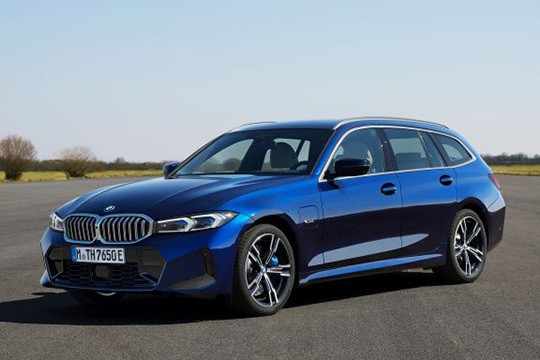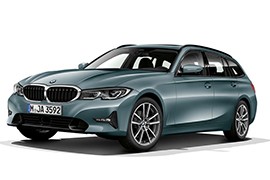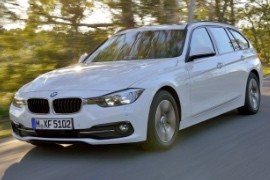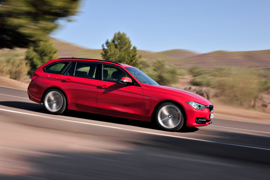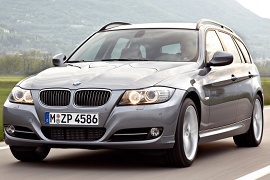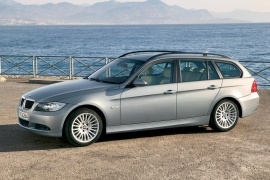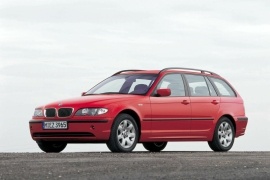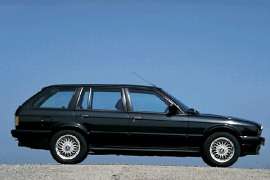BMW 3 Series Touring Models/Series Timeline, Specifications & Photos
First production year: 1988
Engines: Mild hybrid diesel, Gasoline, Hybrid gasoline, Mild hybrid, Diesel
Body style: Wagon (station wagon, estate, combi, touring)
BMW refreshed the seventh generation of the 3 Series in 2022 and, besides the sedan, the station wagon was upgraded as well.
In 1985, BMW introduced a station wagon version for the 3 Series, named Touring. It was a big hit for the German carmaker, especially since there were not too many choices for premium station wagons in the compact segment.
The carmaker revised the car's exterior by introducing new, narrower headlights that were available with adaptive LEDs. Moreover, the car received a few options for the front bumpers, including an option for the M Sport Package and M Sport Package Pro. The latter was newly introduced for the lineup. While the aggressive design was nothing unusual for the sedan, the station wagon usually was not that daring. On the sides, the blacked-out B- and C-pillars tried in vain to resemble a shooting brake. At the back, the available diffuser completed the car's sporty look together with the roof spoiler mounted on top of the tailgate.
Inside, the most significant change was on the dashboard, which featured the BMW Curved Display. In addition, the carmaker installed a 12.3" instrument panel in front of the panel and an additional 14.9" infotainment screen above the center stack. This came with the BMW Operating System 8. As for the trunk space, nothing changed when compared with the 2019 3 Series Touring.
Under the hood, BMW installed a wide choice of engines, ranging between 148 hp (150 PS) and 369 hp (374 PS), with either four or six cylinders fed by gasoline or diesel. Moreover, a plug-in hybrid version was also available. Depending on the engine version and options, the power went to the rear or in all corners via a manual or an automatic transmission.
After more than three decades and 1.7 millions cars on the road, BMW brought out the 2019 3 series Touring, the sixth generation of the model. The new station wagon is longer by 76 mm (3 in), reaching a total of 4709 mm (15.4 ft) compared to its predecessor. The wheelbase was increased by 41 mm (1.61 in), thus giving more room for the occupants. The trunk has been increased to a total volume of 500 liters (17.65 cu-ft), which can triple by folding down the rear seats to a total of 1510 liters (53.3 cu-ft).
Inside, the premium feeling is obvious due to the high quality of the materials used, especially if the vehicle is fitted with upper trim levels. A panoramic glass roof is offered as an option to increase the light and atmosphere inside. For the infotainment system, BMW added its newest generation of iDrive.
For the headlights, BMW offers LED fitted as standard with another upgraded LED system available for extra money and, for those who really wants to transform night into a day, the Laserlight, which can light-up the road ahead up to 530 m (1739 ft).
For the engine compartment, BMW installed a base unit with four-cylinders, a 150 hp turbodiesel. The top-version is the M340i with a six-cylinder 3.0-liter unit, which offers 374 hp. An all-wheel-drive system (called xDrive) is available only for engines with power from 190 hp up.
BMW 3 Series Touring (G21) 318d 6MT RWD (150 HP)
BMW 3 Series Touring (G21) 318d 8AT RWD (150 HP)
BMW 3 Series Touring (G21) 320d 6MT FWD (190 HP)
BMW 3 Series Touring (G21) 320d 8AT RWD (190 HP)
BMW 3 Series Touring (G21) 320d xDrive 8AT AWD (190 HP)
In 2016, BMW introduced the facelift for the sixth generation of the 3-Series for all the range, including the station-wagon. Along with some subtle exterior changes, there were some technological upgrades.
Apart from the first generation of the 3-series, all the others were offered with a station-wagon bodywork as well. That would make the F31 the fifth-generation of the Touring version for the 3-Series. The generation was introduced at the 21st Auto Mobil International held at Leipzig in 2012 and it was updated four years later.
For the exterior, the LCI (Life-Cycle Impulse) introduced a new apron with revised air-intakes. The sensor for the optional Active Cruise Control (ACC) was integrated into the central air-intake. For the headlights, a new full-LED option was added to the list. In the rear, a new apron and new standard LED lights were installed.
On the inside, there was a newly crafted center console with a sliding cover for the cup-holders, that was better used for mobile phones. The instrument cluster featured the same four-dials gauges, accompanied on the center stack by a widescreen for the infotainment unit. In the rear, the split-folding seats allowed up to 1500 liters (53 cu-ft) of trunk space if the usual 496 liters (17.5 cu-ft) volume was not enough.
For the engines, 2016 3 Series Touring was available with a choice of gasoline and turbocharged diesel engines, mated to either a 6-speed manual or an 8-speed automatic. The standard transmission was rear-wheel drive while specific versions were fitted with all-wheel-drive.
BMW 3 Series Touring (F31) LCI 316d 6MT (116 HP)
BMW 3 Series Touring (F31) LCI 316d 8AT (116 HP)
BMW 3 Series Touring (F31) LCI 318d 6MT (150 HP)
BMW 3 Series Touring (F31) LCI 318d 8AT (150 HP)
BMW 3 Series Touring (F31) LCI 318d xDrive 6MT (150 HP)
BMW 3 Series Touring (F31) LCI 320d 6MT (190 HP)
BMW 3 Series Touring (F31) LCI 320d 8AT (190 HP)
BMW 3 Series Touring (F31) LCI 320d EfficientDynamics 6MT (163 HP)
BMW 3 Series Touring (F31) LCI 320d EfficientDynamics 8AT (163 HP)
BMW 3 Series Touring (F31) LCI 320d xDrive 6MT (190 HP)
BMW 3 Series Touring (F31) LCI 320d xDrive 8AT (190 HP)
BMW 3 Series Touring (F31) LCI 325d 6MT (218 HP)
BMW 3 Series Touring (F31) LCI 325d 8AT (218 HP)
BMW 3 Series Touring (F31) LCI 330d 8AT (258 HP)
BMW 3 Series Touring (F31) LCI 318i 6MT (136 HP)
BMW 3 Series Touring (F31) LCI 318i 8AT (136 HP)
BMW 3 Series Touring (F31) LCI 320i 6MT (184 HP)
BMW 3 Series Touring (F31) LCI 320i 8AT (184 HP)
BMW 3 Series Touring (F31) LCI 320i xDrive 6MT (184 HP)
BMW 3 Series Touring (F31) LCI 320i xDrive 8AT (184 HP)
BMW 3 Series Touring (F31) LCI 330i 6MT (252 HP)
BMW 3 Series Touring (F31) LCI 330i 8AT (252 HP)
BMW 3 Series Touring (F31) LCI 330i xDrive 8AT (252 HP)
BMW introduced the sixth generation of the 3 Series sedan in late 2011, but, even though it had the station wagon version ready to launch, it did that in 2012.
Ever since the second generation of the 3 Series, BMW understood that customers needed a station wagon for their premium compact vehicle. Moreover, it had to offer a few things that no other automaker could provide. And the Bavarian automaker kept improving the vehicle and reached more and more customers. Moreover, to make the long-roof more desirable, it gave it exclusive options, such as the opening panoramic glass roof.
With the sixth generation of the 3 Series, BMW returned to its initial quest of designing the car with sportier styling. Thus, thanks to the narrowed headlights on the inner side, it made it look sportier. Like its sedan sibling, the Touring version, BMW's designation for station wagons, the F31 sported a broad grille on the lower side of the bumper that also included the foglamps. On the profile, the slightly sloped-down roof and the raked-forward tailgate created a dynamic look of the vehicle.
Inside, at the front, there were no differences between the sedan and its family-oriented stablemate. At the same time, the rear bench featured a 40/20/40 split-folding system that allowed an increase in the trunk space from a decent 495 liters (17.5 cu-ft) to a respectable 1,500 liters (53 cu-ft). But this wasn't the only advantage when compared to its four-door sibling. The Touring also provided better headroom for the rear passengers, although the transmission tunnel limited the legroom for the middle-seated occupant.
Under the hood, BMW offered a wide engine choice for the 3 Series Touring customers. Power ranged between a mere 134 hp (136 PS) and 302 hp (306 PS). Depending on the engine version, the car was available with either a six-speed manual or an eight-speed automatic. In addition, the automaker offered a choice of rear- or all-wheel drive systems.
BMW 3 Series Touring (F31) 316d 6MT RWD (116 HP)
BMW 3 Series Touring (F31) 316d 8AT RWD (116 HP)
BMW 3 Series Touring (F31) 318d 6MT RWD (143 HP)
BMW 3 Series Touring (F31) 318d 8AT RWD (143 HP)
BMW 3 Series Touring (F31) 318d xDrive 6MT AWD (143 HP)
BMW 3 Series Touring (F31) 320d 6MT RWD (184 HP)
BMW 3 Series Touring (F31) 320d 8AT RWD (184 HP)
BMW 3 Series Touring (F31) 320d EfficientDynamics Edition 6MT RWD (163 HP)
BMW 3 Series Touring (F31) 320d EfficientDynamics Edition 8AT RWD (163 HP)
BMW 3 Series Touring (F31) 320d xDrive 6MT AWD (184 HP)
BMW 3 Series Touring (F31) 320d xDrive 8AT AWD (184 HP)
BMW 3 Series Touring (F31) 325d 6MT AWD (218 HP)
BMW 3 Series Touring (F31) 328d xDrive 8AT AWD (184 HP)
BMW 3 Series Touring (F31) 330d 8AT AWD (258 HP)
BMW 3 Series Touring (F31) 316i 6MT RWD (136 HP)
BMW 3 Series Touring (F31) 316i 8AT RWD (136 HP)
BMW 3 Series Touring (F31) 320i 6MT RWD (184 HP)
BMW 3 Series Touring (F31) 320i 8AT RWD (184 HP)
BMW 3 Series Touring (F31) 320i xDrive 6MT AWD (184 HP)
BMW 3 Series Touring (F31) 320i xDrive 8AT AWD (184 HP)
BMW 3 Series Touring (F31) 328i 6MT RWD (245 HP)
BMW 3 Series Touring (F31) 328i 8AT RWD (245 HP)
BMW 3 Series Touring (F31) 328i xDrive 6MT AWD (245 HP)
BMW 3 Series Touring (F31) 328i xDrive 8AT AWD (245 HP)
BMW 3 Series Touring (F31) 335i 6MT RWD (306 HP)
BMW introduced a mid-life cycle refresh for the whole 3-Series range in 2008 and improved the station wagon version named Sports Wagon in North America or Touring in Europe.
The German carmaker had to improve its cars to fit into the Euro 5a emission standards. Since it had to refresh the engines, it added other modifications to the car's exterior and interior. Worth mentioning that the 3-Series was the best-selling BMW model globally.
At the front, the main difference was on the company's "kidney" grille design, which featured rounded interior edges instead of the clear-cut style used before. BMW also included the grille's chromed top rim in the front fascia, not on the hood as it was on the pre-facelifted version. The lower bumper area received a smiling cut instead of the straight one. Further modifications followed in the rear, where the new LED taillights featured smaller reversing lights.
Inside, the most visible change was for the automatic transmission selector. On the 2008 model, BMW adopted the joy-stick system used on the bigger brother 5-Series instead of the classic, linear style with a side gate for the manual mode. The 40/20/40 split-folding bench in the rear allowed the trunk to increase its size from 460 liters (16.2 cu-ft) to 1,385 liters (48.9 cu-ft)
Under the hood, the German carmaker offered a vast engine choice and started it with a 2.0-liter naturally aspirated gasoline unit that provided 136 hp, seven more than its predecessor. For turbo-diesel versions, BMW introduced a fuel-efficient 115 hp unit paired with a 6-speed manual. The carmaker renamed the all-wheel-drive versions as xDrive instead of xD or xI as before.
BMW 3 Series Touring (E91) 316d 6MT RWD (115 HP)
BMW 3 Series Touring (E91) 318d 6AT (143 HP)
BMW 3 Series Touring (E91) 318d 6MT (143 HP)
BMW 3 Series Touring (E91) 320d 6AT (177 HP)
BMW 3 Series Touring (E91) 320d 6AT (184 HP)
BMW 3 Series Touring (E91) 320d 6MT (177 HP)
BMW 3 Series Touring (E91) 320d 6MT (184 HP)
BMW 3 Series Touring (E91) 320d xDrive 6AT (177 HP)
BMW 3 Series Touring (E91) 320d xDrive 6AT (184 HP)
BMW 3 Series Touring (E91) 320d xDrive 6MT (177 HP)
BMW 3 Series Touring (E91) 320d xDrive 6MT (184 HP)
BMW 3 Series Touring (E91) 325d 6AT (197 HP)
BMW 3 Series Touring (E91) 325d 6AT (204 HP)
BMW 3 Series Touring (E91) 325d 6MT (197 HP)
BMW 3 Series Touring (E91) 325d 6MT (204 HP)
BMW 3 Series Touring (E91) 330d 6AT (245 HP)
BMW 3 Series Touring (E91) 330d 6MT (245 HP)
BMW 3 Series Touring (E91) 318i 6AT (136 HP)
BMW 3 Series Touring (E91) 318i 6AT (143 HP)
BMW 3 Series Touring (E91) 318i 6MT (136 HP)
BMW 3 Series Touring (E91) 318i 6MT (143 HP)
BMW 3 Series Touring (E91) 320i 6AT (170 HP)
BMW 3 Series Touring (E91) 320i 6MT (170 HP)
BMW 3 Series Touring (E91) 325i 6AT (218 HP)
BMW 3 Series Touring (E91) 325i 6MT (218 HP)
BMW 3 Series Touring (E91) 325i xDrive 6AT (218 HP)
BMW 3 Series Touring (E91) 325i xDrive 6MT (218 HP)
BMW 3 Series Touring (E91) 330i 6AT (272 HP)
BMW 3 Series Touring (E91) 330i 6MT (272 HP)
BMW 3 Series Touring (E91) 330i xDrive 6AT (272 HP)
BMW 3 Series Touring (E91) 330i xDrive 6MT (272 HP)
BMW 3 Series Touring (E91) 335i 6AT (306 HP)
BMW 3 Series Touring (E91) 335i 6MT (306 HP)
After the great success the Bavarian manufacturer had with the 4th generation of the 3-series, namely the E46, BMW decided it was time for a brand new model that would still turn heads.
The new 3-series, also named E90 (sedan), E91 (touring), E92 (coupe) and E93 (cabriolet) had a completely redesigned body, using lines inspired from the 5-series.
Compared to the E46, the new model came with a larger wheelbase, thus enhancing passenger comfort. BMW claimed that the boot size was also better, however, the spare tire disappeared starting with 2005. The new 3-series ran on run-flat tires and such the storage space was increased.
The new E90’s body was by 25% stiffer than the older’s model and, of course, safety was enhanced. Other safety features included ABS, dynamic stability control, traction control and others.
Specific to the brand, the timeless design of the E90 attracted buyers for many years, while still keeping its value.
Coming with a variety of engines, the new model could satisfy the needs of every driver. While most of the powerplants were punchy, the fuel consumption was kept as low as possible.
And while it’s not always about how many ponies are to be found under the hood, the E90 offered a great driving experience with its precise steering and great handling.
As we like to say, the BMWs were and still are designed for the most pretentious drivers.
BMW 3 Series Touring (E91) 318d 6MT RWD (122 HP)
BMW 3 Series Touring (E91) 318d 6MT RWD (143 HP)
BMW 3 Series Touring (E91) 320d 6AT RWD (163 HP)
BMW 3 Series Touring (E91) 320d 6AT RWD (177 HP)
BMW 3 Series Touring (E91) 320d 6MT RWD (163 HP)
BMW 3 Series Touring (E91) 320d 6MT RWD (177 HP)
BMW 3 Series Touring (E91) 325d 6AT RWD (197 HP)
BMW 3 Series Touring (E91) 325d 6MT RWD (197 HP)
BMW 3 Series Touring (E91) 330d 6AT RWD (231 HP)
BMW 3 Series Touring (E91) 330d 6MT RWD (231 HP)
BMW 3 Series Touring (E91) 330xd 6AT AWD (231 HP)
BMW 3 Series Touring (E91) 318i 6AT RWD (129 HP)
BMW 3 Series Touring (E91) 318i 6MT RWD (129 HP)
BMW 3 Series Touring (E91) 320i 6AT RWD (150 HP)
BMW 3 Series Touring (E91) 320i 6AT RWD (170 HP)
BMW 3 Series Touring (E91) 320i 6MT RWD (150 HP)
BMW 3 Series Touring (E91) 320i 6MT RWD (170 HP)
BMW 3 Series Touring (E91) 325i 6AT RWD (218 HP)
BMW 3 Series Touring (E91) 325i 6MT RWD (218 HP)
BMW 3 Series Touring (E91) 325xi 6AT AWD (218 HP)
BMW 3 Series Touring (E91) 325xi 6MT AWD (218 HP)
BMW 3 Series Touring (E91) 330i 6AT RWD (258 HP)
BMW 3 Series Touring (E91) 330i 6AT RWD (272 HP)
BMW 3 Series Touring (E91) 330i 6MT RWD (258 HP)
BMW 3 Series Touring (E91) 330i 6MT RWD (272 HP)
BMW 3 Series Touring (E91) 330xi 6AT AWD (258 HP)
BMW 3 Series Touring (E91) 330xi 6AT AWD (272 HP)
BMW 3 Series Touring (E91) 330xi 6MT AWD (258 HP)
BMW 3 Series Touring (E91) 330xi 6MT AWD (272 HP)
BMW 3 Series Touring (E91) 335i 6AT RWD (306 HP)
BMW 3 Series Touring (E91) 335i 6MT RWD (306 HP)
BMW introduced a facelifted version of its 3-Series in 2001 and improved it to match its main competitor, the C-Class from Mercedes.
Ever since the 3-Series E30, BMW offered its compact segment contender in a station wagon shape, fit for those who needed a car for the family but didn't want to give up to the sporty rear-wheel-drive feeling. When the E46 (fourth generation) came on the market in 1998, the Touring (station wagon) was already planned. By 2001, the car's image was already old, and the carmaker already had the refreshed version cooked and ready to go.
From the outside, there were minor changes to the bodywork. The distinctive new look of the headlights, with a double curved line on the bottom, matched the new bumper. At the back, there were no changes to the taillights or the bumper.
Inside, the carmaker introduced new options for steering wheels and installed paddle shifters for the automated (SMG) transmission. The center console received more buttons for additional safety equipment (Dynamic Stability Control). A significant improvement was for the infotainment unit, which received a color screen for the navigation system.
The most important change was for the drivetrain, where a new engine lineup was introduced. The base model was a 1.8-liter unit, named 316i, which offered 115 hp. The most popular version was the 318i, which offered a 2.0-liter unit rated at 143 hp. It was the first 2.0-liter with four cylinders installed on a BMW since the first generation. Top of the range version was the 231 hp 3.0-liter unit, which could have been mated to a 6-speed manual with a rear or all-wheel-drive system. All versions were available with an automatic, 5-speed transmission.
BMW 3 Series Touring (E46) 316i 5AT (115 HP)
BMW 3 Series Touring (E46) 316i 5MT (115 HP)
BMW 3 Series Touring (E46) 318i 5AT (143 HP)
BMW 3 Series Touring (E46) 318i 5MT (143 HP)
BMW 3 Series Touring (E46) 320i 5AT (170 HP)
BMW 3 Series Touring (E46) 320i 5MT (170 HP)
BMW 3 Series Touring (E46) 325i 5AT (192 HP)
BMW 3 Series Touring (E46) 325i 5MT (192 HP)
BMW 3 Series Touring (E46) 325xi 5AT (192 HP)
BMW 3 Series Touring (E46) 325xi 5MT (192 HP)
BMW 3 Series Touring (E46) 330i 5AT (231 HP)
BMW 3 Series Touring (E46) 330i 5MT (231 HP)
BMW 3 Series Touring (E46) 330i 6MT (231 HP)
BMW 3 Series Touring (E46) 330xi 5AT (231 HP)
BMW 3 Series Touring (E46) 318d 5AT (115 HP)
BMW 3 Series Touring (E46) 318d 5MT (115 HP)
BMW 3 Series Touring (E46) 320d 5AT (150 HP)
BMW 3 Series Touring (E46) 320d 5MT (150 HP)
BMW 3 Series Touring (E46) 320d 6MT (150 HP)
BMW 3 Series Touring (E46) 330d 5AT (184 HP)
BMW 3 Series Touring (E46) 330d 5AT (204 HP)
BMW 3 Series Touring (E46) 330d 5MT (184 HP)
BMW 3 Series Touring (E46) 330d 6MT (204 HP)
BMW 3 Series Touring (E46) 330xd 5AT (184 HP)
BMW introduced the fourth generation of the 3 Series in 1997 as a sedan, followed by the coupe in 1998 and the station wagon, which the automaker named Touring, in 1999.
With the fourth generation of the 3 Series (BMW internal code E46), the premium compact vehicle became more family-friendly. Still, the automaker didn’t rush to introduce it. But when it did, the car enjoyed great success in Europe. In the U.S., it wasn’t such a big hit. Furthermore, the car manufacturer didn’t offer it with as many engines as in Europe. Nevertheless, the car enjoyed great success among those looking for a spacious and practical family car that could also keep up with sports cars when needed, especially if fitted with proper engines.
As expected, it shared its front fascia with the rest of the BMW 3 Series range, featuring the same headlights with a double curvature on their lower side. The designer, Chris Bangle, tried to make the car look tamed down compared to its predecessor, and the 3 Series didn’t have such an aggressive appearance anymore. Up to the B-pillar, both versions, the sedan, and the Touring, shared the same bodywork panels, but things were different from there on.
While many automakers cut development costs by using the same rear doors on sedans and station wagons, BMW didn’t do that. It redesigned them and installed an upright frame for the windows. Behind the C-pillars, the automaker installed a third row of windows that flanked the trunk space. At the back, the 3 Series Touring sported a tilted-forward tailgate that was, depending on the options, adorned by a tiny roof spoiler. The rear bumper featured black rubber stripes that protected the bodywork against small scratches.
Inside, at the front, the 3 Series featured a pair of bucket seats with slight side bolstered areas for most versions. Still, BMW offered customers the option for leather-wrapped interior and high-bolstered seats at the front. The driver fronted an instrument cluster filled with two large dials for the speedometer and tachometer and the gauges for fuel level and temperature. In the back, there was enough room for two passengers on long journeys or three for short jaunts due to the tall transmission tunnel. The trunk could be expanded by lowering the rear split-folding seatback (60/40) of the bench seat. To ease loading and unloading, customers had the option to open the entire tailgate or just the rear window, a feature that was carried over from the first 3 Series Touring, the E30.
Depending on the market, the E46 Touring featured a wide choice of engines that ranged between 1.9-liter and 3.0-liter paired with either five-speed manual or automatic gearboxes. In addition, the car was available with either a rear- or an all-wheel-drive system, marking the return of the X-Drive on the compact-sized BMW lineup after it was denied for the 3 Series, E36 generation.
BMW 3 Series Touring (E46) 318i 4AT (118 HP)
BMW 3 Series Touring (E46) 318i 5MT (118 HP)
BMW 3 Series Touring (E46) 320i 5AT (150 HP)
BMW 3 Series Touring (E46) 320i 5AT (170 HP)
BMW 3 Series Touring (E46) 320i 5MT (150 HP)
BMW 3 Series Touring (E46) 320i 5MT (170 HP)
BMW 3 Series Touring (E46) 325i 5AT (192 HP)
BMW 3 Series Touring (E46) 325i 5MT (192 HP)
BMW 3 Series Touring (E46) 325xi 5AT (192 HP)
BMW 3 Series Touring (E46) 325xi 5MT (192 HP)
BMW 3 Series Touring (E46) 328i 5AT (193 HP)
BMW 3 Series Touring (E46) 328i 5MT (193 HP)
BMW 3 Series Touring (E46) 330i 5AT (231 HP)
BMW 3 Series Touring (E46) 330i 5MT (231 HP)
The second generation of the 3-Series was launched in 1982 but it wasn't until the car's mid-life cycle refresh until the station-wagon was launched. It was the first 3-Series that had the Touring name.
The station-wagon mania started in the mid-'80s and the premium manufacturers didn't offer that kind of bodywork on the compact-sized vehicles. While Mercedes-Benz and Audi already had station-wagons in its lineup, BMW didn't have anything to offer in that segment.
The 3-Series touring was the same car from the grille to the B-pillars, but after that, it was changed with a longer roof, different rear quarter panels, and the addition of the D-pillars. The C-pillars were slimmer than those from the sedan. The tailgate featured an innovative system with the window opening independently from the rest of the tailgate, or together with it.
Inside, there was no difference in headroom between the sedan and the touring since the sedan already featured a long roof. The rear seats featured a folding seatback to extend the trunk space. It also kept the go-through folding panel to allow ski-transport.
The 3-Series Touring was offered with 4 and 6 cylinders engines, both gasoline and diesel. The introduction of the all-wheel-drive system for the 325 iX version was also introduced for the station-wagon.
BMW 3 Series Touring (E30) 316i 4AT (99 HP)
BMW 3 Series Touring (E30) 316i 5MT (99 HP)
BMW 3 Series Touring (E30) 318i 4AT (113 HP)
BMW 3 Series Touring (E30) 318i 5MT (113 HP)
BMW 3 Series Touring (E30) 320i 4AT (129 HP)
BMW 3 Series Touring (E30) 320i 5MT (129 HP)
BMW 3 Series Touring (E30) 325i 4AT (170 HP)
BMW 3 Series Touring (E30) 325i 5MT (170 HP)
